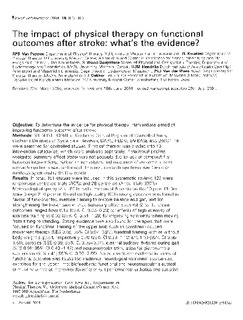| dc.contributor.author | Van Peppen, R.P. | |
| dc.contributor.author | Kwakkel, G. | |
| dc.contributor.author | Wood-Dauphinee, S. | |
| dc.contributor.author | Hendriks, H.J. | |
| dc.contributor.author | Van der Wees, P.J. | |
| dc.contributor.author | Dekker, J. | |
| dc.date.accessioned | 2018-04-24T08:14:45Z | |
| dc.date.available | 2018-04-24T08:14:45Z | |
| dc.date.issued | 2004 | |
| dc.identifier.citation | Van Peppen, R. P., Kwakkel, G., Wood-Dauphinee, S., Hendriks, H. J., Van der Wees, P. J., & Dekker, J. (2004). The impact of physical therapy on functional outcomes after stroke: what's the evidence? Clin Rehabil, 18(8), 833-862. | nb_NO |
| dc.identifier.uri | http://hdl.handle.net/11250/2495590 | |
| dc.description.abstract | Objective: To determine the evidence for physical therapy interventions aimed at improving functional outcome after stroke.
Methods: MEDLINE, CINAHL, Cochrane Central Register of Controlled Trials, Cochrane Database of Systematic Reviews, DARE, PEDro, EMBASE and DocOnline were searched for controlled studies. Physical therapy was divided into 10 intervention categories, which were analysed separately. If statistical pooling (weighted summary effect sizes) was not possible due to lack of comparability between interventions, patient characteristics and measures of outcome, a bestresearch synthesis was performed. This best-research synthesis was based on methodological quality (PEDro score).
Results: In total, 151 studies were included in this systematic review; 123 were randomized controlled trials (RCTs) and 28 controlled clinical trials (CCTs). Methodological quality of all RCTs had a median of 5 points on the 10-point PEDro scale (range 2–8 points). Based on high-quality RCTs strong evidence was found in favour of task-oriented exercise training to restore balance and gait, and for strengthening the lower paretic limb. Summary effect sizes (SES) for functional outcomes ranged from 0.13 (95% CI 0.03–0.23) for effects of high intensity of exercise training to 0.92 (95% CI 0.54–1.29) for improving symmetry when moving from sitting to standing. Strong evidence was also found for therapies that were focused on functional training of the upper limb such as constraint-induced movement therapy (SES 0.46; 95% CI 0.07–0.91), treadmill training with or without body weight support, respectively 0.70 (95% CI 0.29–1.10) and 1.09 (95% CI 0.56–1.61), aerobics (SES 0.39; 95% CI 0.05–0.74), external auditory rhythms during gait (SES 0.91; 95% CI 0.40–1.42) and neuromuscular stimulation for glenohumeral subluxation (SES 1.41; 95% CI 0.76–2.06). No or insufficient evidence in terms of functional outcome was found for: traditional neurological treatment approaches; exercises for the upper limb; biofeedback; functional and neuromuscular electrical stimulation aimed at improving dexterity or gait performance; orthotics and assistive devices; and physical therapy interventions for reducing hemiplegic shoulder pain and hand oedema.
Conclusions: This review showed small to large effect sizes for task-oriented exercise training, in particular when applied intensively and early after stroke onset. In almost all high-quality RCTs, effects were mainly restricted to tasks directly trained in the exercise programme. | nb_NO |
| dc.publisher | Clinical Rehabilitation | nb_NO |
| dc.subject | physical therapy | nb_NO |
| dc.subject | functional outcomes | nb_NO |
| dc.subject | stroke | nb_NO |
| dc.title | The impact of physical therapy on functional outcomes after stroke: what's the evidence? | nb_NO |
| dc.type | Journal article | nb_NO |
| dc.source.pagenumber | 833-862 | nb_NO |
| dc.source.volume | 18 | nb_NO |
| dc.source.journal | Clinical Rehabilitation | nb_NO |
| dc.source.issue | 8 | nb_NO |
| dc.identifier.doi | 10.1191/0269215504cr843oa | |
